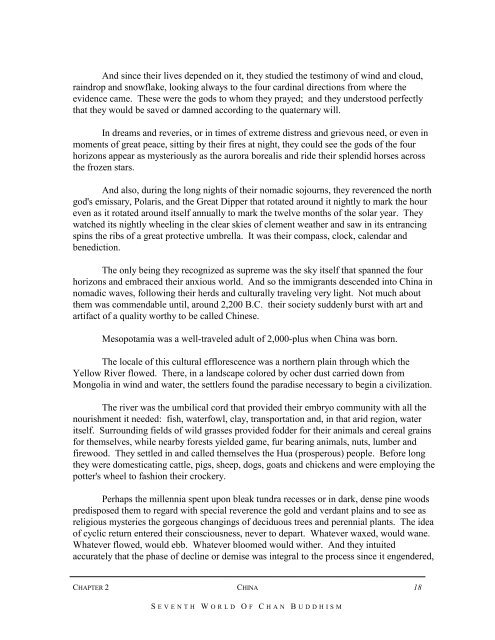seventh world of chan buddhism - Zen Buddhist Order of Hsu Yun
seventh world of chan buddhism - Zen Buddhist Order of Hsu Yun
seventh world of chan buddhism - Zen Buddhist Order of Hsu Yun
You also want an ePaper? Increase the reach of your titles
YUMPU automatically turns print PDFs into web optimized ePapers that Google loves.
And since their lives depended on it, they studied the testimony <strong>of</strong> wind and cloud,<br />
raindrop and snowflake, looking always to the four cardinal directions from where the<br />
evidence came. These were the gods to whom they prayed; and they understood perfectly<br />
that they would be saved or damned according to the quaternary will.<br />
In dreams and reveries, or in times <strong>of</strong> extreme distress and grievous need, or even in<br />
moments <strong>of</strong> great peace, sitting by their fires at night, they could see the gods <strong>of</strong> the four<br />
horizons appear as mysteriously as the aurora borealis and ride their splendid horses across<br />
the frozen stars.<br />
And also, during the long nights <strong>of</strong> their nomadic sojourns, they reverenced the north<br />
god's emissary, Polaris, and the Great Dipper that rotated around it nightly to mark the hour<br />
even as it rotated around itself annually to mark the twelve months <strong>of</strong> the solar year. They<br />
watched its nightly wheeling in the clear skies <strong>of</strong> clement weather and saw in its entrancing<br />
spins the ribs <strong>of</strong> a great protective umbrella. It was their compass, clock, calendar and<br />
benediction.<br />
The only being they recognized as supreme was the sky itself that spanned the four<br />
horizons and embraced their anxious <strong>world</strong>. And so the immigrants descended into China in<br />
nomadic waves, following their herds and culturally traveling very light. Not much about<br />
them was commendable until, around 2,200 B.C. their society suddenly burst with art and<br />
artifact <strong>of</strong> a quality worthy to be called Chinese.<br />
Mesopotamia was a well-traveled adult <strong>of</strong> 2,000-plus when China was born.<br />
The locale <strong>of</strong> this cultural efflorescence was a northern plain through which the<br />
Yellow River flowed. There, in a landscape colored by ocher dust carried down from<br />
Mongolia in wind and water, the settlers found the paradise necessary to begin a civilization.<br />
The river was the umbilical cord that provided their embryo community with all the<br />
nourishment it needed: fish, waterfowl, clay, transportation and, in that arid region, water<br />
itself. Surrounding fields <strong>of</strong> wild grasses provided fodder for their animals and cereal grains<br />
for themselves, while nearby forests yielded game, fur bearing animals, nuts, lumber and<br />
firewood. They settled in and called themselves the Hua (prosperous) people. Before long<br />
they were domesticating cattle, pigs, sheep, dogs, goats and chickens and were employing the<br />
potter's wheel to fashion their crockery.<br />
Perhaps the millennia spent upon bleak tundra recesses or in dark, dense pine woods<br />
predisposed them to regard with special reverence the gold and verdant plains and to see as<br />
religious mysteries the gorgeous <strong>chan</strong>gings <strong>of</strong> deciduous trees and perennial plants. The idea<br />
<strong>of</strong> cyclic return entered their consciousness, never to depart. Whatever waxed, would wane.<br />
Whatever flowed, would ebb. Whatever bloomed would wither. And they intuited<br />
accurately that the phase <strong>of</strong> decline or demise was integral to the process since it engendered,<br />
CHAPTER 2 CHINA<br />
S EVENTH W ORLD O F C HAN B UDDHISM<br />
18


